
15 Days Yunnan-Sichuan-Qinghai Kham Tibetan Overland Tour
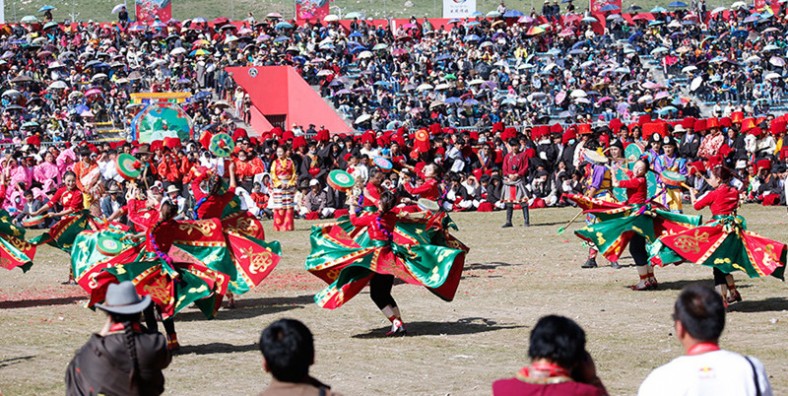
Tour Overview
This 15 Days Yunnan-Sichuan-Qinghai Kham Tibetan Overland Tour from Lijiang overflows with stunning scenery, and the route itsef involves part of Yunnan-Tibet highway, part of Sichuan-Tibet highway, and part of Qinghai-Tibet...
Code of Tour: YCT0000003510
Length of Travel: 15 Day
Destinations of Tour: Lijiang-Shangrila-Daocheng-Litang-Dege-Yushu-Xining
Departure City: Lijiang
Price of Tour: Request
Type of Tour:
Features of Tour: Nature Culture Minority Landscape
This 15 Days Yunnan-Sichuan-Qinghai Kham Tibetan Overland Tour from Lijiang overflows with stunning scenery, and the route itsef involves part of Yunnan-Tibet highway, part of Sichuan-Tibet highway, and part of Qinghai-Tibet highway with highlights of all highways perfectly combined. Besides, you will first visit the city highlights of Lijiang and Shangri-La including the grand Tiger Leaping Gorge. Then, move on to visit some extremely difficult-to-get-to monasteries. Along your way, you will meet the most charming snow mountains, tranquil lakes, shimmering rivers, rare animals and Tibetan Villages. Finally, you will arrive at Xining and finish your tour after experiencing the unique Tibetan Buddhism culture in the famous monasteries of Yushu and Xining.
Highlights:
- Visit the top attractions of Lijiang and Shangri-La including the grand Tiger Leaping Gorge.
- Meet snown mountains, tranquil lakes, shimmering rivers, Tibetan villages and rare animals on your way.
- Visit some extremely difficult-to-get-to monasteries along your way to experience the Tibetan Buddhism.
Brief Itinerary
- Day 1: Lijiang Arrival
- Day 2: Lijiang-Shangri-La
- Day 3: Shangri-La-Derong
- Day 4: Derong-Batang
- Day 5: Batang-Litang
- Day 6: Litang-Xinlong
- Day 7: Xinlong-Baiyu
- Day 8: Baiyu-Dege
- Day 9: Dege-Yihun Lhatso
- Day 10: Yihun Lhatso-Shiqu
- Day 11: Shiqu–Yushu
- Day 12: Yushu
- Day 13: Yushu-Huashixia
- Day 14: Huashixia-Xining
- Day 15: Xining Departure
Google Map
Detailed Itinerary
Day 1 Arrive in Lijiang
Sightseeing and Activities:Lijiang Arrival
Accommodation:Lijiang
Meals:None
Pick you up in the airport then transfer to your hotel. If time permits, explore Lijiang Ancient Town on your own. Lijiang Ancient Town has a history of more than 800 years; it was listed as the World Cultural Heritage by the UNESCO 1997.
Day 2 Lijiang – Shangri-La
Sightseeing and Activities:the First Bend of Yangtze River, Shigu Ancient Town, the Red Army’s Long March Memorial Monument, Stone Drum, Iron Chain Bridge, Tiger Leaping Gorge, Dukezong Ancient Town, Giant Prayer Wheel
Accommodation:Shangri-La
Meals:Breakfast, Lunch
From Lijiang, you’ll drive about 60KM to the First Bend on the Yangtze River with imposing gorge scenery, the Red Army’s Long March Memorial Monument and the Iron Chain Bridge in Stone Drum Town. The town of Stone Drum got its name from a large, cylindrical, marble tablet shaped like a drum. The scenery is magnificent as the road running through the Lijiang valley which is filled with wheat fields and drying haystacks. You will have an experience of the floating from the First Bend of the Yangtze River to Longpan Town, after one hour floating, meet the driver and trasfer to Tiger Leaping Gorge.
Visit the Tiger Leaping Gorge, the deepest gorge in the world. With 34 rapids of the Yangtze River, it is called the Jinsha in this area because you can find gold in the river. Afternoon, you’ll head for Shangri-La, the former Zhongdian which is welknown as the paradise destination for every tourist. Upon arrival in Shangri-La, you will have entered the Tibetan cultural area and a landscape of barley fields and yaks scattered in the valleys. Walk around Dukezong Ancient Town, an important town of the Ancient Tea-horse Trade Caravan from Yunnan to Tibet and India.
Day 3 Shangri-La-Derong
Sightseeing and Activities:Benzilan Town
Accommodation:Camping
Meals:Breakfast, Lunch
From Zhongdian it’s an easy 2-hour ride to the Tibetan Benzilan Town on the banks of the Yangtze, which for centuries was an important stop on the old trading route into Tibet (indeed in central Tibet, imported Chinese tea was often known as ‘Benzilan tea’!). Here the road crosses the Yangtze to enter Sichuan, following a windy road towards Derong, through a landscape of dipping valleys and steep river banks, dotted with typical signs of a Tibetan area – prayer stones, stupas, and flags. Derong itself, small but thriving, is tucked tightly in a gorge of the Ding-chu river which the town straddles. Camping tonight.
Day 4 Derong-Batang
Sightseeing and Activities:Wutsi Nature Reserve, Batang Gompa
Accommodation:Batang Guest House
Meals:Breakfast, Lunch
This is a less trodden route, as the rougher roads will testify, following the Yangtze upstream through a pretty valley which skirts the Wutsi Nature Reserve, on a relatively untrodden road north-west to Batang. Set in a wide, prosperous valley alongside the Batang River, it’s just over 30 km east of the Yangtze-TAR border. Its low (for these parts!) altitude (2470m) gives it a mild climate, and the town itself, though small, rates as quite a hub of activity (boasts its own radio station!) owing to flow of trans-border traffic made of truckers plying the Lhasa-Chengdu route. Two sites worth seeing are the Batang Gompa (Gelukpa since 1639), heavily damaged in Sino-Tibetan wars of 20c, some amazing frescoes destroyed, it’s been gradually repaired over the years. Some 400 monks reside, and the Jakyung Rito Pendeling Gon – smaller and older. Overnight at local Guesthouse.
Day 5 Batang-Litang
Sightseeing and Activities:Litang Gompa
Accommodation:Litang
Meals:Breakfast, Lunch
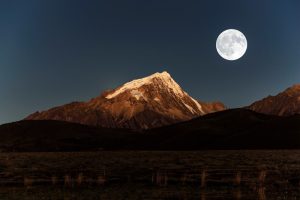
Trail heads due east on the main Sichuan-Tibet highway, following the Batang river gorge upstream to the township of Taksha. Trail then ascends a pass (4230m) offering some views of high mountain lakes and empty plains indicative of this area’s extreme environment, uniquely suited for nomadic pastoralism. Crossing a watershed pass (separating the Batang and Li river systems) we’re soon arriving in Litang, which at 4100m is one of the highest towns in the world, set on a broad grassland with Lithang Gompa dominating it from the north. Litang itself has played a central part in the region, from its days as an independent Kingdom, allied with Kagyü rulers of the Kingdom of Dêrge, through its absorption by the great Gelukpa expansion east in the 16th, 17th & 18th centuries, to its position as a (nominal) outpost of the Qing dynasty all the way through to its role as a centre of resistance in the Khampa uprising against the incoming PLA in the 1950’s. As with Ganzi further north, it’s a market town and administrative centre, heavily coloured by its roots as a trading post for the Khampa nomads that populate the high plains.
Day 6 Litang-Xinlong
Sightseeing and Activities:Litang Gompa, Zera Gompa
Accommodation:Xinlong
Meals:Breakfast, Lunch
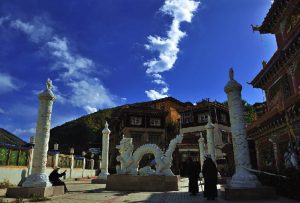
Up early to catch Litang’s superb morning views and pay a visit to Lithang Gompa, a huge monastery complex and one of Kham’s most prominent Gelukpa centres, founded 1580. After breakfast a day’s extreme back-country drive, north as the trails wends its way through forested valleys and grassland, to Xinlong, capital of Nyarong county and largely unvisited due to a road only recently completed/repaired Xinlong is a small town set alongside the banks of the Yalong River, largely unvisited due to a road only recently repaired/completed. It’s the capital of Nyarong county, a relatively poor area compared to its neighbours. Set atop the hill behind town is Zera Gompa, a teaching monastery with about upwards of 50 monks here.
Day 7 Xinlong-Baiyu
Sightseeing and Activities:Nyarong Valley, Pelyul Gompa, Katok Gompa
Accommodation:Baiyu Local Guest House
Meals:Breakfast, Lunch
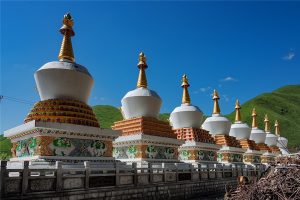
From Xinlong follow the the steep gorge of the Nyarong Valley due south into deep Nyingmapa country, following the Yalong through a forested, fairly secluded valley. Then veer west on a little travelled road past the Dorkho Gompa (Sakyapa) before reaching Baiyu, a pretty Tibetan town with tree-lined streets and the river Ding-chu flowing through it. The important Pelyul Gompa (Nyingmapa) is located atop a hill behind town. Today can choose to continue on to Katok Gompa – from Baiyu follow the Yangtze (on the other side of which is the TAR) to Hepo. The early 12c Katok gompa is located 850m above town. Excepting Samye (near Lhasa) this is the oldest surviving Nyingmapa monastery, a hugely religiously significant site, a privilege to be able to visit it.
Day 8 Baiyu-Dege
Sightseeing and Activities:Pelpung Gompa,Parkhang Printery, Gonchen Gompa
Accommodation:Dege
Meals:Breakfast, Lunch
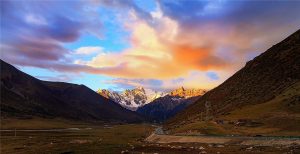
Not a whole lot of miles covered this day, so to have time to do the detour to Pelpung Gompa via a scenic narrow road. The establishment of this 18c monastery quickly made this region the centre for the Karma Kagyüpa school. It’s been designated one of world’s most important endangered monuments by World Monuments Fund. It’s a huge complex, visible for miles from its hilltop perch. Known as the Little Potala, some reckon its architecture to be Kham’s most stunning. Back on the main road, continue following the Yangtze to Dege, a remote city with a long history, once the seat of the Kingdom of Dêrge, whose kings ruled this area independent of interference from either Lhasa or Beijing. Its most famous building is the Parkhang Printery, the main source of printed materials for much of the Kham area. Today it’s possible to observe the monks at work, using the same age-old wood block techniques. Gonchen Gompa, largely gutted, has now been restored, but with the original shell largely intact.
Day 9 Yihun Lhatso (Xinluhai)/ Manigange
Sightseeing and Activities:Yihun Lhatso
Accommodation:Yihun Lhatso Shore/Manigange Local Guest House
Meals:Breakfast, Lunch
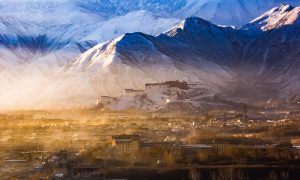
From Dege, the trail is enveloped between the steep sides of the Zi-chu river gorge, before ascending a series of switchbacks up to Tro La (4916m), leaving behind the forests and snowy peaks to crest onto a vast grassland. Soon visible is Yihun Lhatso (4500m), a beautiful blue lake surrounded by snowy mountains, held very sacred by Tibetans as evidenced by all the mani stone piles and prayer flags. Weather providing, camp tonight along its banks, with the glaciered 6186m Mt. Que’er as the backdrop if lucky. Or can opt to continue to the wild west town of Manigange on the Sichuan-Qinghai ‘highway’, home to Yazer gompa (Nyingma).
Day 10 Yihun Lhatso-Shiqu
Sightseeing and Activities:Muri La Pass, Dzogchen Gompa,Tsatsa gompa, Rinyur Gompa
Accommodation:Shiqu Local Guest House
Meals:Breakfast, Lunch

Proceed north over a fantastic (and tarmacked!) stretch of road across wide nomad country rarely visited by outsiders, that foreshadows the huge grasslands of Amdo, still a couple of days north. First cross the 4633m Muri La Pass, then nearby, set in a ‘hidden valley’, is the 17c Dzogchen Gompa (Nyingmapa), one of the most important monasteries in Kham and a renowned school for teachings of Dzogchen. Time providing also make a detour to visit Zhechen Gompa via a pristine valley surrounded by mountains, as well as Tsatsa Gompa and Rinyur Gompa, before arriving for the evening to Shiqu – recently a small concrete town filled mostly with Han Chinese PLA and police, it’s now a busy market town, mostly Tibetan. Bumnying Gompa (Gelukpa) is here, home to some 200 monks.
Day 11 Shiqu-Yushu
Sightseeing and Activities:Sershul Gompa, Tibetan Village
Accommodation:Yushu
Meals:Breakfast, Lunch
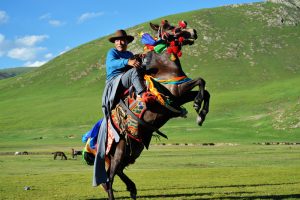
A little outside of Shiqu is the Sershul Gompa, probably the only monastery you’ll ever see built with pink (!) tiles – a large and obviously rich monastery, it’s a bit more Han Buddhist than Tibetan Buddhist, overlooking a Tibetan village. The countryside rises from hills and plains to wide open grasslands, fantastic stuff. Lunch in the tiny hamlet of Xiewu, combined with a visit to the Sakyapa Monastery set on the hillside above town. The roue then heads south to Yushu, en route passing Gyanak Mani – a football field-sized pile of mani stones which must surely be the largest such mani dui from here to Lhasa – before finally arriving at the hopping town of Yushu.
Day 12 Yushu area
Sightseeing and Activities:Jyekundo Gompa ,Benchen Gomp
Accommodation:Yushu
Meals:Breakfast, Lunch
A relatively big town, there’s plenty of street life to entertain oneself, and even a few internet cafes. Jyekundo Gompa (Sakyapa) on a hill overlooking town is worth a visit, before heading out of town to see some of the sites (the 7c Wencheng Temple, Benchen Gompa, Trangu Gompa).
Day 13 Yushu-Huashixia
Sightseeing and Activities:Drubgyuling Gompa
Accommodation:Huashixia
Meals:Breakfast, Lunch
Retracing part of the trail from a couple days ago to Xiewu, cross the border of Kham, leaving the gorge country of Kham and head into Amdo Tibet, birth place of many of the DLs and an area strong in Mongol influence. It’s a great road dotted by yaks and the black-haired yak tents of the Golok nomads, sightings of the Asiatic wild ass (kiang) and the Tibetan Gazelle relatively common, amid vast rolling plateaus surrounded by distant mountains. The road climbs steeply to Drubgyuling Gompa, well worth a visit, with hundreds of young student lamas. At Huashixia, a one-yak truck stop providing only the most basic of accommodation, turn right and the unmistakable profile of Machen Gangri (6282m) – the highest peak of the Amnye Machen (Magyel Pomra) range, held sacred by all schools of Tibetan Buddhism as well as by Golok nomads and followers of Bön – is soon visible.
Day 14 Huashixia-Xining
Sightseeing and Activities:Kumbum Gompa
Accommodation:Xining
Meals:Breakfast, Lunch
An early start for the long haul north over the high grasslands to the major metropolis of Xining. A high remote road (generally over 4000m) through empty land populated only by the Golok people, offering vast views, small towns, and the ubiquitous Muslim Hui restaurant. Closer to Xining, can pay a visit to Kumbum Gompa, famous and revered as the site where Tsongkhapa (founder of the Gelukpa order) was born. Rather museum-like and touristy compared with what we’ve seen so far, it’s interesting for a visit if just to note the contrast. The city of Xining dates back to early Qing dynasty, when it was established to serve as imperial China’s administrative seat for this region. Today’s it’s still a major hub, and a place where comfortable beds and hot showers are in abundance.
Day 15 Departure from Xining City
Sightseeing and Activities:Departure from Xining City
Accommodation:None
Meals:Breakfast
Transfer to Xining Airport for returning. Service ends.
Recommended Hotels
| Destination | 5 Star | 4 Star | 3 Star |
| Lijiang | Pullman Hotel | Wangfu Hotel | Liwang Hotel |
| Shangri-La | Shangri-La Hotel | Shangri-La Old Town Hotel | Moon City Hotel |
| Litang | / | Chongcao Hotel | Mei Duo Smart Hotel |
| Xinlong | / | Danxia Hotel | Xinliang Hotel |
| Dege | / | Queershan Hotel | Foyuan Hotel |
| Shiqu | / | Xiangde Nima Hotel | Shike Wangguo Hotel |
| Yushu | Gesar Palace Hotel Yushu | Sun Lake Holiday Hotel | Airport Hotel |
| Xining | Wanda Realm Xining | Mehood Hotel (Xining Haihu New District) | Home Inn Plus |
Service Included:
- Admission fees for all of the sightseeing spots listed in the itinerary;
- Meals as listed in the itinerary;
- Accommodation with breakfast as listed in the itinerary;
- Private English-speaking tour guide and vehicle for transfers & sightseeing;
- Service charge & government taxes;
- Luggage transfers between airports and hotels;
- Two bottles of mineral water each day.
Service Excluded:
- Any arrival and departure international airfares or train tickets;
- Chinese visa fees;
- Excess baggage charged by Airlines;
- Single room supplement;
- Tips to guides and drivers;
- Personal expenses and gratuities to service staff;
- Personal travel insurance;
- All optional programs;
- Domestic air tickets fares with airport tax and fuel extra fee based on economy class mentioned in the program.
Travel Tips:
- Tibet Permits
There are several permits required to visit Tibet. Tibet Entry Permit, issued by Tibet Tourism Bureau, is the most important one which has to be obtained before your trip because you must have it to take your flight/train to Tibet. To get the permit, you have to book a Tibet tour with us, and send us your passport and Chinese visa about 20 days in advance, and then let us apply for the permit (all Tibet permits can only be applied by travel agency). If you travel to other prefectures like Shigatse, Nyingchi, Shannan, etc, you also have to obtain an Alien Travel Permit. If you travel to Mount Everest, you have to obtain a Border Permit. (Tibet Discovery, with office in Lhasa, has always kept up with the latest news on Tibet Permits. Traveling with us, all your permits are guaranteed as long as you are qualified to the requirements.)
- Available Months to Visit Tibet
Generally speaking, May to early October is the best time to for a Mount Kailash trip. July and August are the peak season and rainy season. It may be too cold to travel in Kailash area from November to March. There is usually heavy snow. The conditions in Namtso Lake and Mount Everest area are quite similar with Kailash. While other places like Lhasa, Gyantse and Shigatse are suitable for travel all year around.
- High Altitude Sickness
The average altitude of Tibet is about 4000 meters above the sea level (Lhasa: 3700m; EBC: 5200m; Namtso: 4718m). You may suffer a bit from High Altitude Sickness in the beginning days of your Tibet trip if you haven’t had rich high plateau travel experience. But don’t worry too much, the high altitude can be acclimatized usually in 2~3 days. Our suggestion is to take a physical examination and get suggestions from your doctor, and also bring some medicines to prevent from High Altitude Sickness before your trip. While in Tibet, you should keep warm all the time, avoid strenuous activities, drink more water and eat more vegetables and carbohydrates. You’d better not take showers during the first two days after your arrival at Tibet. If you don’t feel well, get help from your tour guide or go to the hospital without any delay.
- How to Go to Tibet
Basically you have two options – flight and train. Currently, you can take a flight to Lhasa from Beijing(4.5hrs), Xian(3.7hrs), Chengdu(2.5hrs), Chongqing(3hrs), Kuming(3hrs), etc. Among all these cities, Chengdu and Xian have more frequent flights to Lhasa. Kathmandu also has several flights to Lhasa each week.
If you a train travel, you can take a train to from Beijing(40.5hrs), Xian(32hrs), Chengdu(43hrs), Shanghai(47hrs), Chongqing(42hrs), Lanzhou(25hrs), Xining(22hrs), Guangzhou(54hrs).
- Packing and Wearing Ideas
Firstly you can’t forget your passport and Chinese Visa. A large backpack and a smaller one are recommended (the smaller one can be used for daily activities). Also bring the necessary medicine you need. Other stuffs like sunglasses, snow glasses, hats, lip balm, sun block are recommended. As for wearing, you are suggested to dress in layers (both thin and thick jackets). Down jacket is necessary in Spring and Autumn. A pair of durable and comfortable shoes is necessary.

















